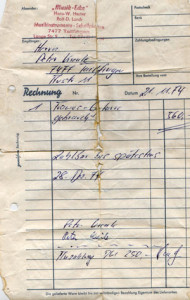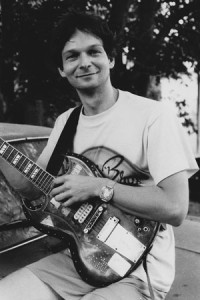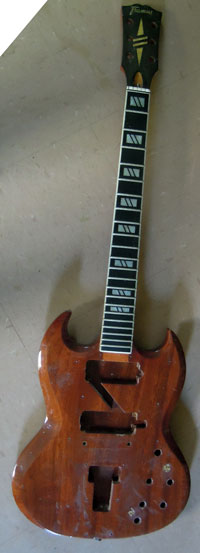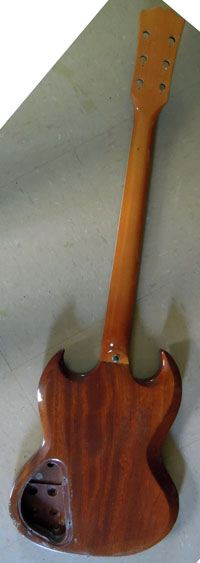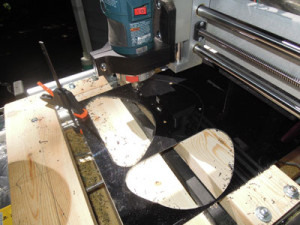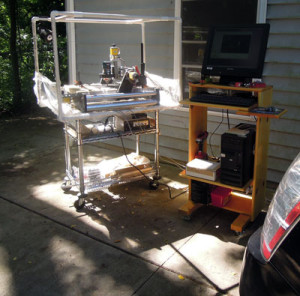Restoring my first electric guitar
Last week I finally finished the restoration of my first electric guitar. A Framus S370 – basically a German Gibson SG copy. I didn’t quite find out when this was built – probably very early 1970s. I bought it used from Musik Ecke in Albstadt, West Germany. When I opened the rear cover I found the original invoice which dates my purchase to November 1974.
This guitar was in great shape when I got it. Then, a few years later, I decided to replace the stock neck pickup with a DiMarzio humbucker. This is when the onslaught started. The measurements of the pickup openings and placements of the screw holes are not standard and to my shock the DiMarzio upgrade was not as easy as I thought. Having no access to tools other than a pair of scissors, a screwdriver and a soldering iron I “adapted” the opening and through the ingenious use of molten polystyrene plastic (left over from some Revell model airplanes) I added the proper mounting holes to the pickup. A little more here.
All the markings, stickers, dirt and gunk was added to this instrument when I was a teenager. The stickers are a normal thing as I just learned from my daughter Melody who coincidentally got her first electric guitar, an Epiphone SG copy, a while ago. Brand new, and it already has stickers all over. What turned out to be an enormous headache in the restoration was some sort of “metal-protection” spray a friend had recommended. Essentially all metal (or chrome) parts received the treatment. I guess that’s what made all the gunk stick to the guitar.
This guitar has appeared on many of my recordings. It was tuned in minor sevenths for a recording project in the early 80s. When I was experimenting with my Chapman Stick it was tuned in all fifths to emulate the bass side of the Stick – the lowest two strings where old strings from a bass.
I ordered a pair of new pickups from Stewart McDonalds guitar supplies and some other hardware. When I took the guitar apart to start the process the body looked fine and after some acetone application to remove the grime things started looking up.
The real problem were the plastic covers. The small one covering the electronics in the back and the pickguard. I just didn’t find a way to remove the stickers without scratching the plastic. Also, the pickup openings and screw holes didn’t agree with the new pickup dimensions.
A good first “real” job for my Fireball V90 CNC machine, I thought. I didn’t have the V90 very long and little experience. Never done anything more complicated than some wood working. It took some time to actually establish a pipeline to get the dimensions and shapes into Cambam plus (which makes the control code for the machine.) The first pipeline (Adobe Illustrator to trace the scan, Cinema 4D to make it into a 3D model and then Cambam to make the gcode) somehow shrank the shapes just enough that it wasn’t visible on screen. That was frustrating. The solution was to keep it 2D and bypass Cinema 4D. It took two sheets of ABS plastic to finally get everything correct. The fourth cut was it. I am not doing this professionally!
After much cleaning, filing, polishing, soldering – and after almost 40 years of abuse – the neck needed only a little truss rod adjustment. This guitar has always played very well. Framus necks from that era are a bit beefy but I like it that way. Also I really like the huge rectangular fret markers. Most other guitars I own are very frugal in that regard and on a dark stage it is often hard to glimpse where your hand is on the neck.
That was a very satisfying project and I am very happy I invested the time and effort. I can’t wait to take this “new” 40 year old guitar on a gig.

